Experiments on Energy-Efficient Evaporative Cooling Systems for Poultry Farm Application in Multan (Pakistan)
Abstract
1. Introduction
1.1. Background
1.2. Heat Stress and Poultry Air-Conditioning
2. Evaporative Cooling Systems
2.1. Direct Evaporative Cooling (DEC)
2.2. Indirect Evaporative Cooling (IEC)
2.3. M-Cycle Evaporative Cooling (MEC)
3. Materials and Methods
Mathematical Models for Poultry Heat Generation
4. Results and Discussion
5. Conclusions
Author Contributions
Funding
Institutional Review Board Statement
Informed Consent Statement
Data Availability Statement
Acknowledgments
Conflicts of Interest
Abbreviations
| EC | evaporative cooling |
| GDP | gross domestic product |
| DBT | dry-bulb temperature |
| RH | relative humidity |
| THI | temperature-humidity index |
| THVI | temperature-humidity-velocity index |
| DEC | direct evaporative cooling |
| IEC | indirect evaporative cooling |
| MEC | M-cycle evaporative cooling |
| Q | heat produced (Q/kg) |
| W | Live weight (kg) |
| SHP | sensible heat production (W/kg) |
| LHP | latent heat production (W/kg) |
| x | bird’s age (days) |
| SE | standard error of regression. |
| ET | thermal exposure time |
References
- Rehman, A.; Jingdong, L.; Du, Y. Last five years Pakistan economic growth rate (GDP) and its comparison with China, India and Bangladesh. Inter. J. Technol. Enhanc. Emerg. Eng. Res. 2015, 4, 81–86. [Google Scholar]
- Rehman, A.; Jingdong, L.; Chandio, A.A.; Hussain, I. Livestock production and population census in Pakistan: Determining their relationship with agricultural GDP using econometric analysis. Inf. Process. Agric. 2017, 4, 168–177. [Google Scholar] [CrossRef]
- FBS Pakistan Statistical Year Book. Available online: http://www.pbs.gov.pk/content/pakistan-statistical-year-book-2017 (accessed on 12 January 2021).
- Marangoni, F.; Corsello, G.; Cricelli, C.; Ferrara, N.; Ghiselli, A.; Lucchin, L.; Poli, A. Role of poultry meat in a balanced diet aimed at maintaining health and wellbeing: An Italian consensus document. Food Nutr. Res. 2015, 59, 27606. [Google Scholar] [CrossRef]
- Pedrazzi, S.; Allesina, G.; Muscio, A. Indirect evaporative cooling by sub-roof forced ventilation to counter extreme heat events. Energy Build. 2020, 229, 110491. [Google Scholar] [CrossRef]
- Perkins, S.E. A review on the scientific understanding of heatwaves—Their measurement, driving mechanisms, and changes at the global scale. Atmos. Res. 2015, 164, 242–267. [Google Scholar] [CrossRef]
- Poku, R.; Oyinki, T.W.; Ogbonnaya, E.A. The effects of evaporative cooling in tropical climate. Am. J. Mech. Eng. 2017, 5, 145–150. [Google Scholar] [CrossRef]
- Yahav, S. Regulation of body temperature: Strategies and mechanisms. In Sturkie’s Avian Physiology; Elsevier: Amsterdam, The Netherlands, 2015; pp. 869–905. [Google Scholar]
- Van Kampen, M.; Mitchell, B.W.; Siegel, H.S. Thermoneutral zone of chickens as determined by measuring heat production, respiration rate, and electromyographic and electroencephalographic activity in light and dark environments and changing ambient temperatures. J. Agric. Sci. 1979, 92, 219–226. [Google Scholar] [CrossRef]
- Sultan, M.; El-Sharkawy, I.I.; Miyazaki, T.; Saha, B.B.; Koyama, S. An overview of solid desiccant dehumidification and air conditioning systems. Renew. Sustain. Energy Rev. 2015, 46, 16–29. [Google Scholar] [CrossRef]
- Xin, H.; Berry, I.L.; Tabler, G.T.; Barton, T.L. Temperature and humidity profiles of broiler houses with experimental conventional and tunnel ventilation systems. Appl. Eng. Agric. 1994, 10, 535–542. [Google Scholar] [CrossRef]
- Donkoh, A. Ambient temperature: A factor affecting performance and physiological response of broiler chickens. Int. J. Biometeorol. 1989, 33, 259–265. [Google Scholar] [CrossRef]
- Habeeb, A.A.; Gad, A.E.; Atta, M.A. Temperature-Humidity Indices as Indicators to Heat Stress of Climatic Conditions with Relation to Production and Reproduction of Farm Animals. Int. J. Biotechnol. Recent Adv. 2018, 1, 35–50. [Google Scholar] [CrossRef]
- Youssef, A.; Exadaktylos, V.; Berckmans, D.A. Towards real-time control of chicken activity in a ventilated chamber. Biosyst. Eng. 2015, 135, 31–43. [Google Scholar] [CrossRef]
- Lara, L.J.; Rostagno, M.H. Impact of heat stress on poultry production. Animals 2013, 3, 356–369. [Google Scholar] [CrossRef]
- Estévez, M. Oxidative damage to poultry: From farm to fork. Poult. Sci. 2015, 94, 1368–1378. [Google Scholar] [CrossRef]
- Surai, P.F.; Kochish, I.I.; Fisinin, V.I.; Kidd, M.T. Antioxidant defence systems and oxidative stress in poultry biology: An update. Antioxidants 2019, 8, 235. [Google Scholar] [CrossRef]
- Wasti, S.; Sah, N.; Mishra, B. Impact of heat stress on poultry health and performances, and potential mitigation strategies. Animals 2020, 10, 1266. [Google Scholar] [CrossRef] [PubMed]
- Kashif, M.; Niaz, H.; Sultan, M.; Miyazaki, T.; Feng, Y.; Usman, M.; Shahzad, M.W.; Niaz, Y.; Waqas, M.M.; Ali, I. Study on desiccant and evaporative cooling systems for livestock thermal comfort: Theory and experiments. Energies 2020, 13, 2675. [Google Scholar] [CrossRef]
- Sultan, M.; Miyazaki, T.; Mahmood, M.H.; Khan, Z.M. Solar assisted evaporative cooling based passive air-conditioning system for agricultural and livestock applications. J. Eng. Sci. Technol. 2018, 13, 693–703. [Google Scholar]
- Damerow, G. The Chicken Health Handbook: A Complete Guide to Maximizing Flock Health and Dealing with Disease; Storey Publishing: North Adams, MA, USA, 2016; ISBN 1603428585. [Google Scholar]
- Saeed, M.; Abbas, G.; Alagawany, M.; Kamboh, A.A.; Abd El-Hack, M.E.; Khafaga, A.F.; Chao, S. Heat stress management in poultry farms: A comprehensive overview. J. Therm. Biol. 2019, 84, 414–425. [Google Scholar] [CrossRef]
- Yanagi, T.; Xin, H.; Gates, R.S. A research facility for studying poultry responses to heat stress and its relief. Appl. Eng. Agric. 2002, 18, 255. [Google Scholar] [CrossRef]
- Qian, X.; Yang, Y.; Lee, S.W. Design and Evaluation of the Lab-Scale Shell and Tube Heat Exchanger (STHE) for Poultry Litter to Energy Production. Processes 2020, 8, 500. [Google Scholar] [CrossRef]
- Cui, Y.; Theo, E.; Gurler, T.; Su, Y.; Saffa, R. A comprehensive review on renewable and sustainable heating systems for poultry farming. Int. J. Low-Carbon Technol. 2020, 15, 121–142. [Google Scholar] [CrossRef]
- Yi, B.; Chen, L.; Sa, R.; Zhong, R.; Xing, H.; Zhang, H. High concentrations of atmospheric ammonia induce alterations of gene expression in the breast muscle of broilers (Gallus gallus) based on RNA-Seq. BMC Genomics 2016, 17, 1–11. [Google Scholar] [CrossRef]
- Mashaly, M.M.; Hendricks, G.L., 3rd; Kalama, M.A.; Gehad, A.E.; Abbas, A.O.; Patterson, P.H. Effect of heat stress on production parameters and immune responses of commercial laying hens. Poult. Sci. 2004, 83, 889–894. [Google Scholar] [CrossRef]
- Petek, M.; Dikmen, S.; Oǧan, M.M. Performance analysis of a two stage pad cooling system in broiler houses. Turkish J. Vet. Anim. Sci. 2012, 36, 21–26. [Google Scholar] [CrossRef]
- Raza, H.M.U.; Ashraf, H.; Shahzad, K.; Sultan, M.; Miyazaki, T.; Usman, M.; Shamshiri, R.R.; Zhou, Y.; Ahmad, R. Investigating Applicability of Evaporative Cooling Systems for Thermal Comfort of Poultry Birds in Pakistan. Appl. Sci. 2020, 10, 4445. [Google Scholar] [CrossRef]
- Noor, S.; Ashraf, H.; Sultan, M.; Khan, Z.M. Evaporative Cooling Options for Building Air-Conditioning: A Comprehensive Study for Climatic Conditions of Multan (Pakistan). Energies 2020, 13, 3061. [Google Scholar] [CrossRef]
- Sultan, M.; Miyazaki, T. Energy-Efficient Air-Conditioning Systems for Nonhuman Applications. In Refrigeration; Ekren, O., Ed.; InTech: London, UK, 2017; pp. 97–117. [Google Scholar]
- dos Santos, T.C.; Gates, R.S.; Tinôco, I.; de, F.F.; Zolnier, S.; da Baêta, F.C. Behavior of Japanese quail in different air velocities and air temperatures. Pesqui. Agropecuária Bras. 2017, 52, 344–354. [Google Scholar] [CrossRef]
- Bustamante, E.; García-Diego, F.-J.; Calvet, S.; Estellés, F.; Beltrán, P.; Hospitaler, A.; Torres, A.G. Exploring ventilation efficiency in poultry buildings: The validation of computational fluid dynamics (CFD) in a cross-mechanically ventilated broiler farm. Energies 2013, 6, 2605–2623. [Google Scholar] [CrossRef]
- DeShazer, J.A.; Hahn, G.L.; Xin, H. Basic principles of the thermal environment and livestock energetics. In Livestock Energetics and Thermal Environment Management; American Society of Agricultural and Biological Engineers: St. Joseph, MI, USA, 2009; pp. 1–22. ISBN 1892769743. [Google Scholar]
- Chen, Q.; Pan, N.; Guo, Z.-Y. A new approach to analysis and optimization of evaporative cooling system II: Applications. Energy 2011, 36, 2890–2898. [Google Scholar] [CrossRef]
- Malli, A.; Seyf, H.R.; Layeghi, M.; Sharifian, S.; Behravesh, H. Investigating the performance of cellulosic evaporative cooling pads. Energy Convers. Manag. 2011, 52, 2598–2603. [Google Scholar] [CrossRef]
- De Angelis, A.; Saro, O.; Truant, M. Evaporative cooling systems to improve internal comfort in industrial buildings. Energy Procedia 2017, 126, 313–320. [Google Scholar] [CrossRef]
- Xuan, Y.M.; Xiao, F.; Niu, X.F.; Huang, X.; Wang, S.W. Research and application of evaporative cooling in China: A review (I) - Research. Renew. Sustain. Energy Rev. 2012, 16, 3535–3546. [Google Scholar] [CrossRef]
- Obando, F.A.; Montoya, A.P.; Osorio, J.A.; Damasceno, F.A.; Norton, T. Evaporative pad cooling model validation in a closed dairy cattle building. Biosyst. Eng. 2020, 198, 147–162. [Google Scholar] [CrossRef]
- Kovačević, I.; Sourbron, M. The numerical model for direct evaporative cooler. Appl. Therm. Eng. 2017, 113, 8–19. [Google Scholar] [CrossRef]
- Cuce, P.M.; Riffat, S. A state of the art review of evaporative cooling systems for building applications. Renew. Sustain. Energy Rev. 2016, 54, 1240–1249. [Google Scholar] [CrossRef]
- Panchabikesan, K.; Vellaisamy, K.; Ramalingam, V. Passive cooling potential in buildings under various climatic conditions in India. Renew. Sustain. Energy Rev. 2017, 78, 1236–1252. [Google Scholar] [CrossRef]
- Shahzad, K. Evaluation of Evaporative Cooling Systems for Poultry Air-Conditioning. Master’s Thesis, Bahauddin Zakariya University, Multan, Pakistan, 2018. [Google Scholar]
- Mahmood, M.H.; Sultan, M.; Miyazaki, T.; Koyama, S.; Maisotsenko, V.S. Overview of the Maisotsenko cycle—A way towards dew point evaporative cooling. Renew. Sustain. Energy Rev. 2016, 66, 537–555. [Google Scholar] [CrossRef]
- Mahmood, M.H.; Sultan, M.; Miyazaki, T. Significance of Temperature and Humidity Control for Agricultural Products Storage: Overview of Conventional and Advanced Options. Int. J. Food Eng. 2019, 15. [Google Scholar] [CrossRef]
- Duan, Z.; Zhan, C.; Zhang, X.; Mustafa, M.; Zhao, X.; Alimohammadisagvand, B.; Hasan, A. Indirect evaporative cooling: Past, present and future potentials. Renew. Sustain. Energy Rev. 2012, 16, 6823–6850. [Google Scholar] [CrossRef]
- Sajjad, U.; Abbas, N.; Hamid, K.; Abbas, S.; Hussain, I.; Ammar, S.M.; Sultan, M.; Ali, H.M.; Hussain, M.; ur Rehman, T.; et al. A review of recent advances in indirect evaporative cooling technology. Int. Commun. Heat Mass Transf. 2021, 122, 105140. [Google Scholar] [CrossRef]
- Zhan, C.; Duan, Z.; Zhao, X.; Smith, S.; Jin, H.; Riffat, S. Comparative study of the performance of the M-cycle counter-flow and cross-flow heat exchangers for indirect evaporative cooling—Paving the path toward sustainable cooling of buildings. Energy 2011, 36, 6790–6805. [Google Scholar] [CrossRef]
- Arun, B.S.; Mariappan, V.; Maisotsenko, V. Experimental study on combined low temperature regeneration of liquid desiccant and evaporative cooling by ultrasonic atomization. Int. J. Refrig. 2020, 112, 100–109. [Google Scholar] [CrossRef]
- Pacak, A.; Worek, W. Review of Dew Point Evaporative Cooling Technology for Air Conditioning Applications. Appl. Sci. 2021, 11, 934. [Google Scholar] [CrossRef]
- Shahzad, M.W.; Lin, J.; Bin Xu, B.; Dala, L.; Chen, Q.; Burhan, M.; Sultan, M.; Worek, W.; Ng, K.C. A spatiotemporal indirect evaporative cooler enabled by transiently interceding water mist. Energy 2021, 217, 119352. [Google Scholar] [CrossRef]
- Sultan, M.; Niaz, H.; Miyazaki, T. Investigation of Desiccant and Evaporative Cooling Systems for Animal Air-Conditioning. In Refrigeration and Air-Conditioning; IntechOpen: London, UK, 2019. [Google Scholar]
- Gates, R.S.; Overhults, D.G.; Zhang, S.H. Minimum ventilation for modern broiler facilities. Trans. ASAE 1996, 39, 1135–1144. [Google Scholar] [CrossRef]
- Tao, X.; Xin, H. Surface wetting and its optimization to cool broiler chickens. Trans. ASAE 2003, 46, 483. [Google Scholar]
- Zulovich, J.M.; DeShazer, J.A. Estimating egg production declines at high environmental temperatures and humidities. Pap. Soc. Agric. Eng. 1990, 90-4021, 1–16. [Google Scholar]
- Tao, X.; Xin, H. Acute synergistic effects of air temperature, humidity, and velocity on homeostasis of market-size broilers. Trans. Am. Soc. Agric. Eng. 2003, 46, 491–497. [Google Scholar] [CrossRef]
- Bruno, F. On-site experimental testing of a novel dew point evaporative cooler. Energy Build. 2011, 43, 3475–3483. [Google Scholar] [CrossRef]
- Doğramacı, P.A.; Aydın, D. Comparative experimental investigation of novel organic materials for direct evaporative cooling applications in hot-dry climate. J. Build. Eng. 2020, 30, 101240. [Google Scholar] [CrossRef]
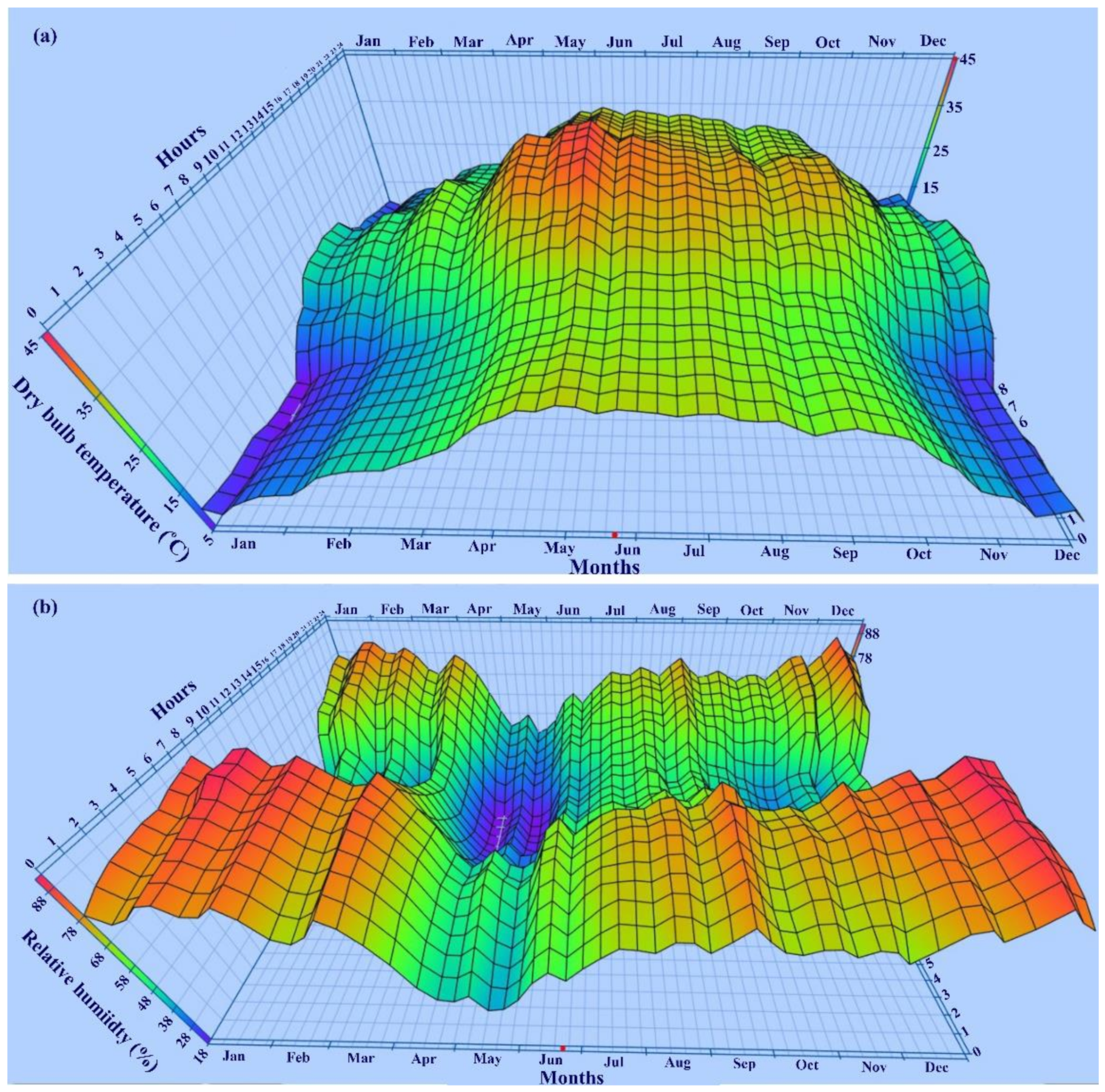
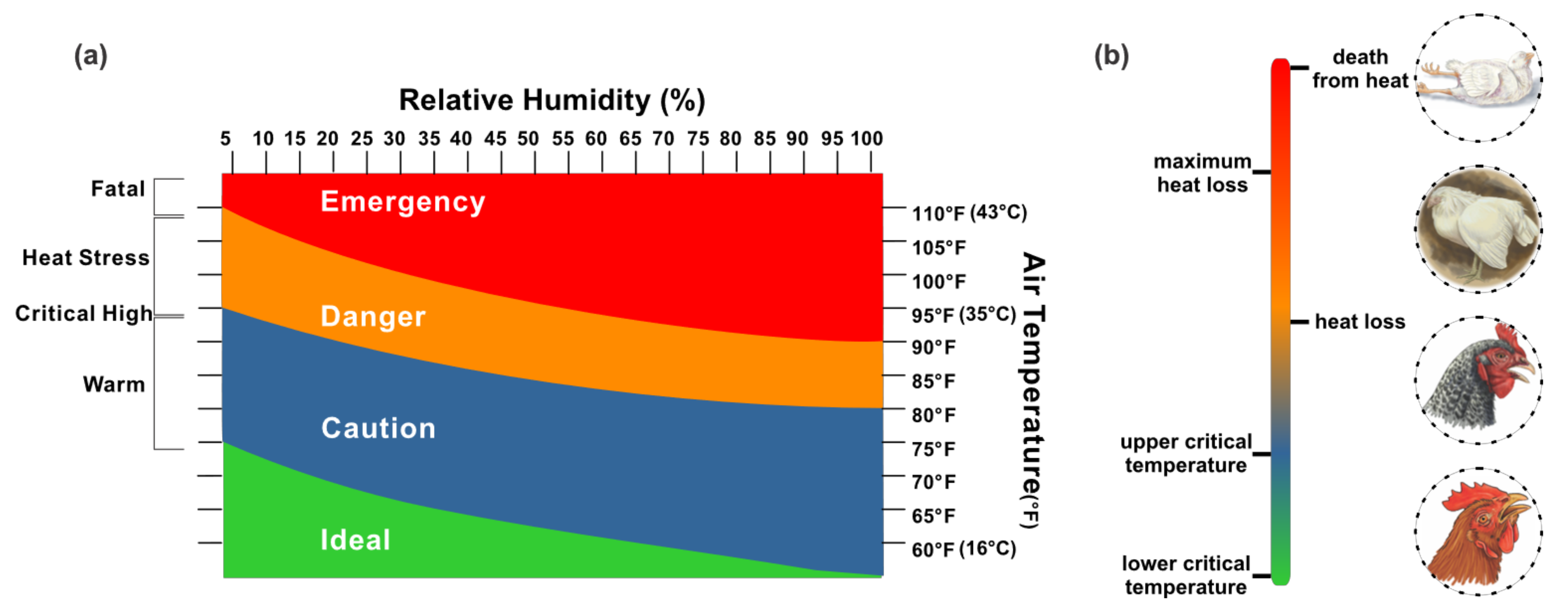


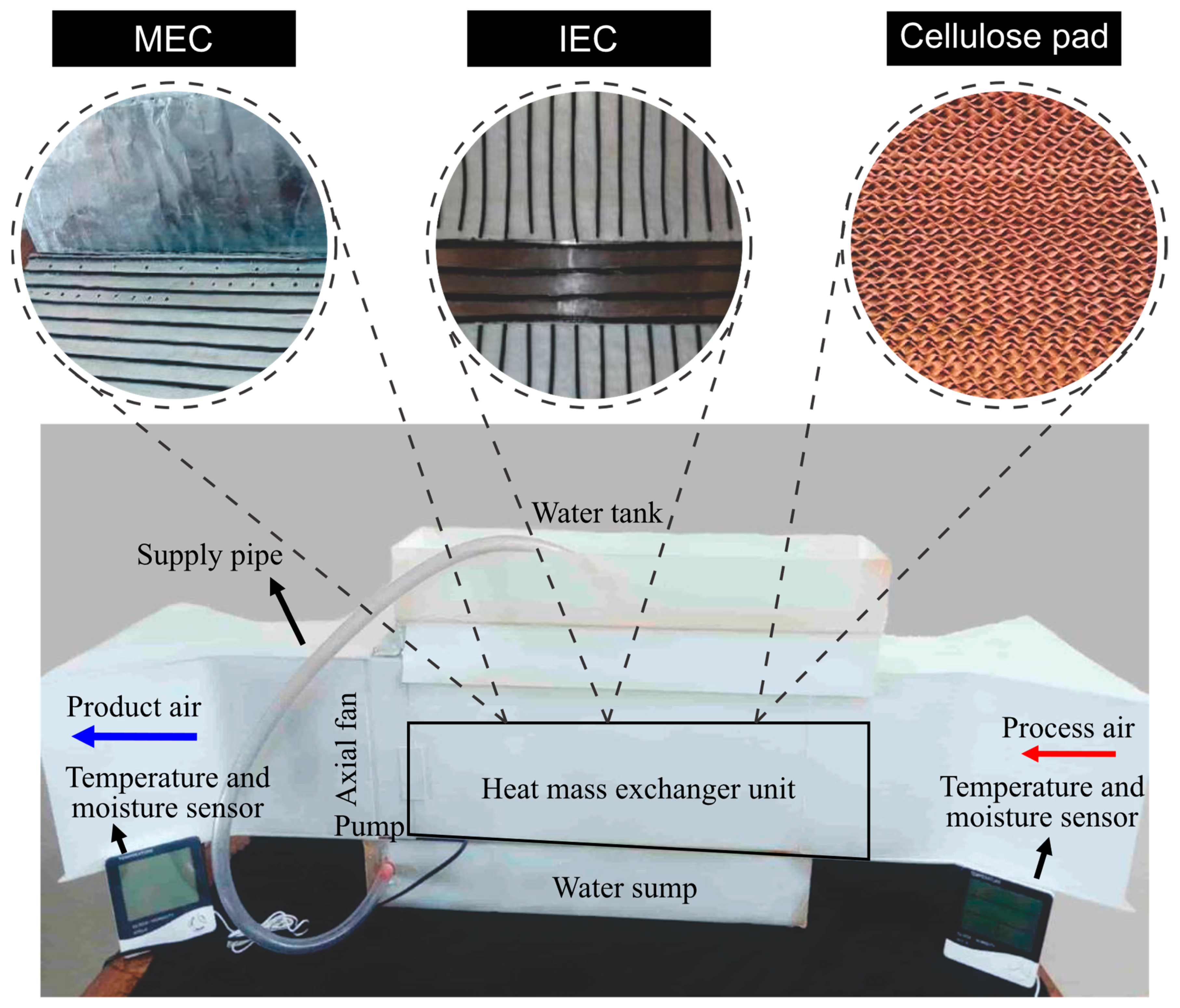

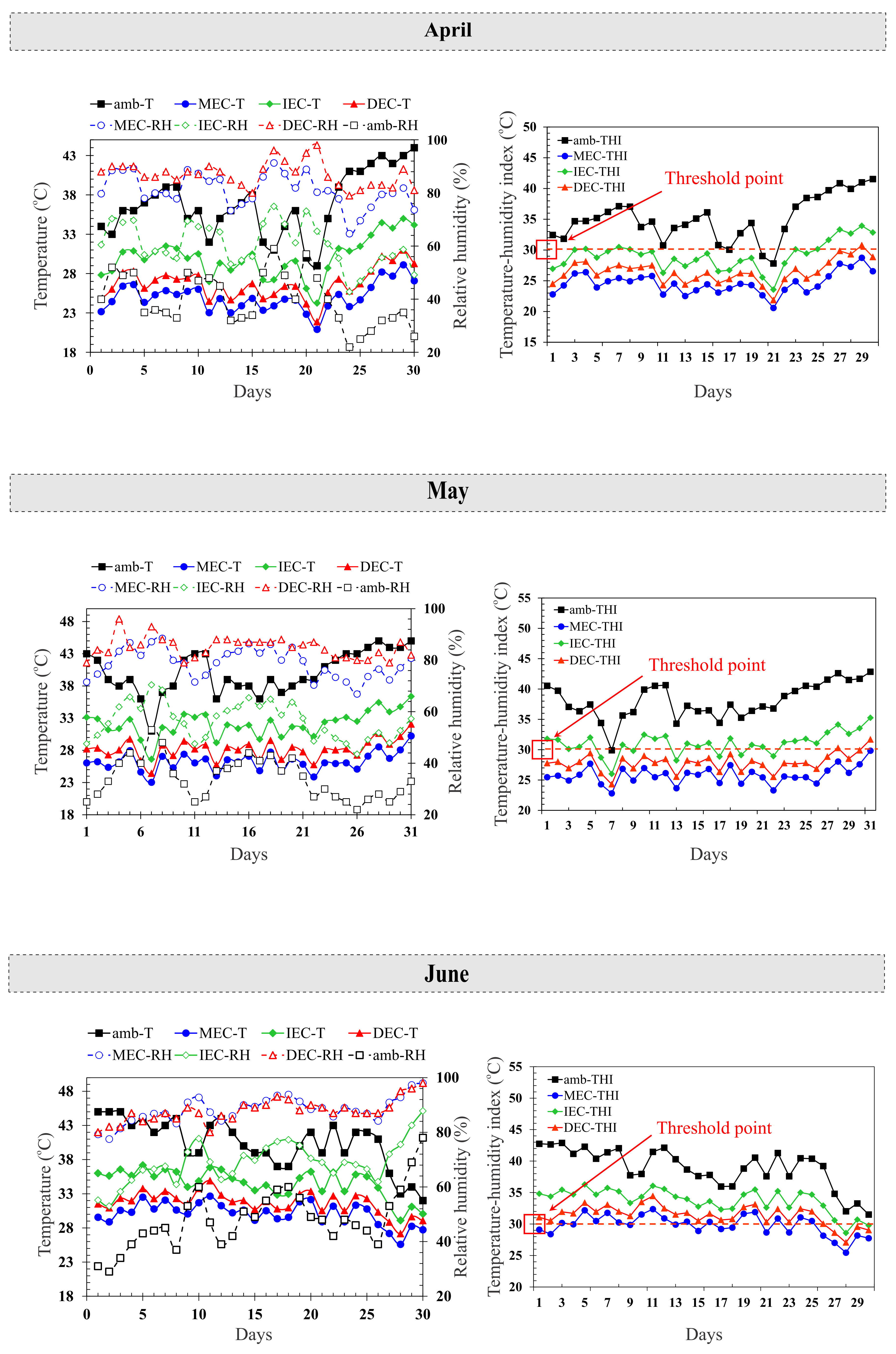
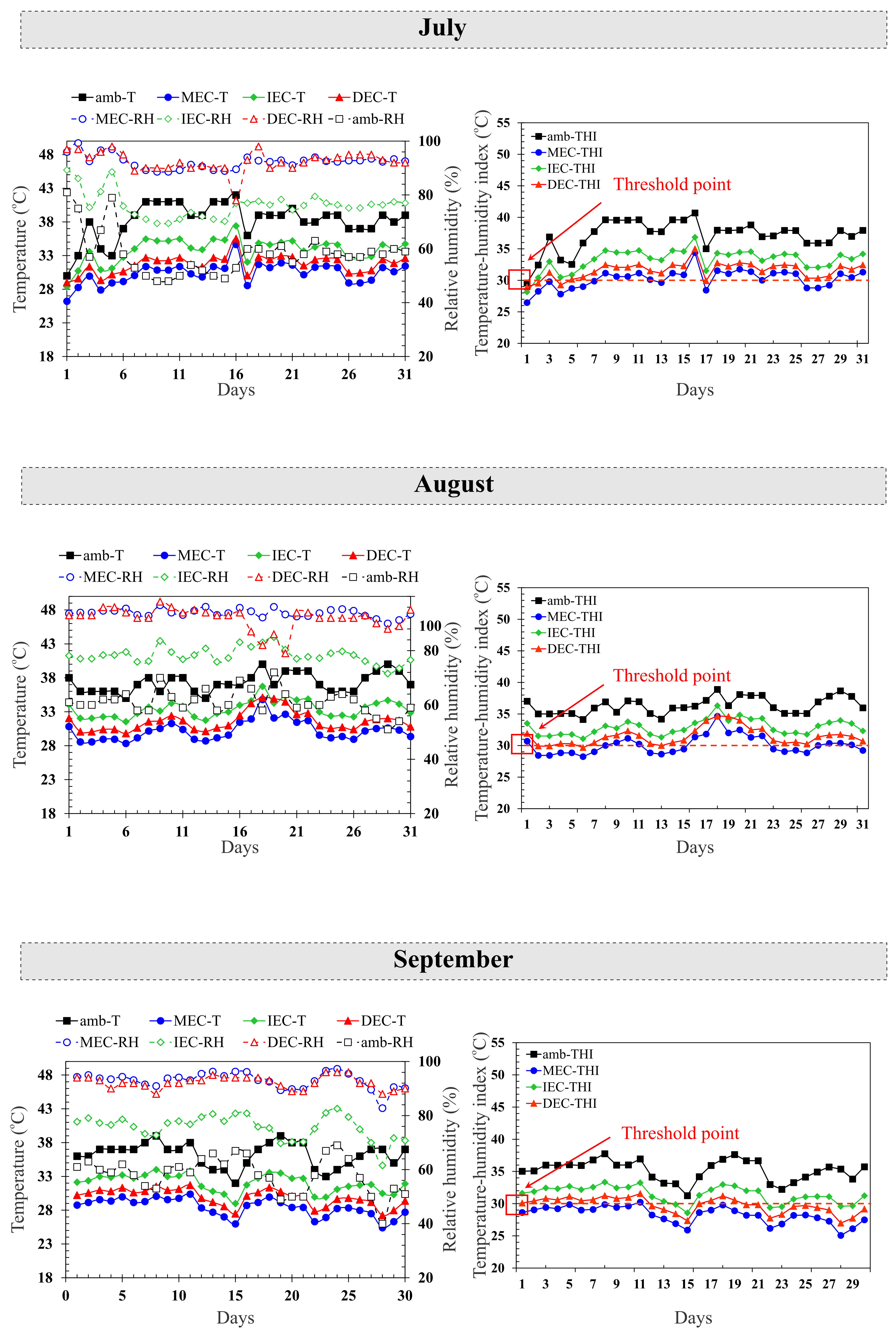
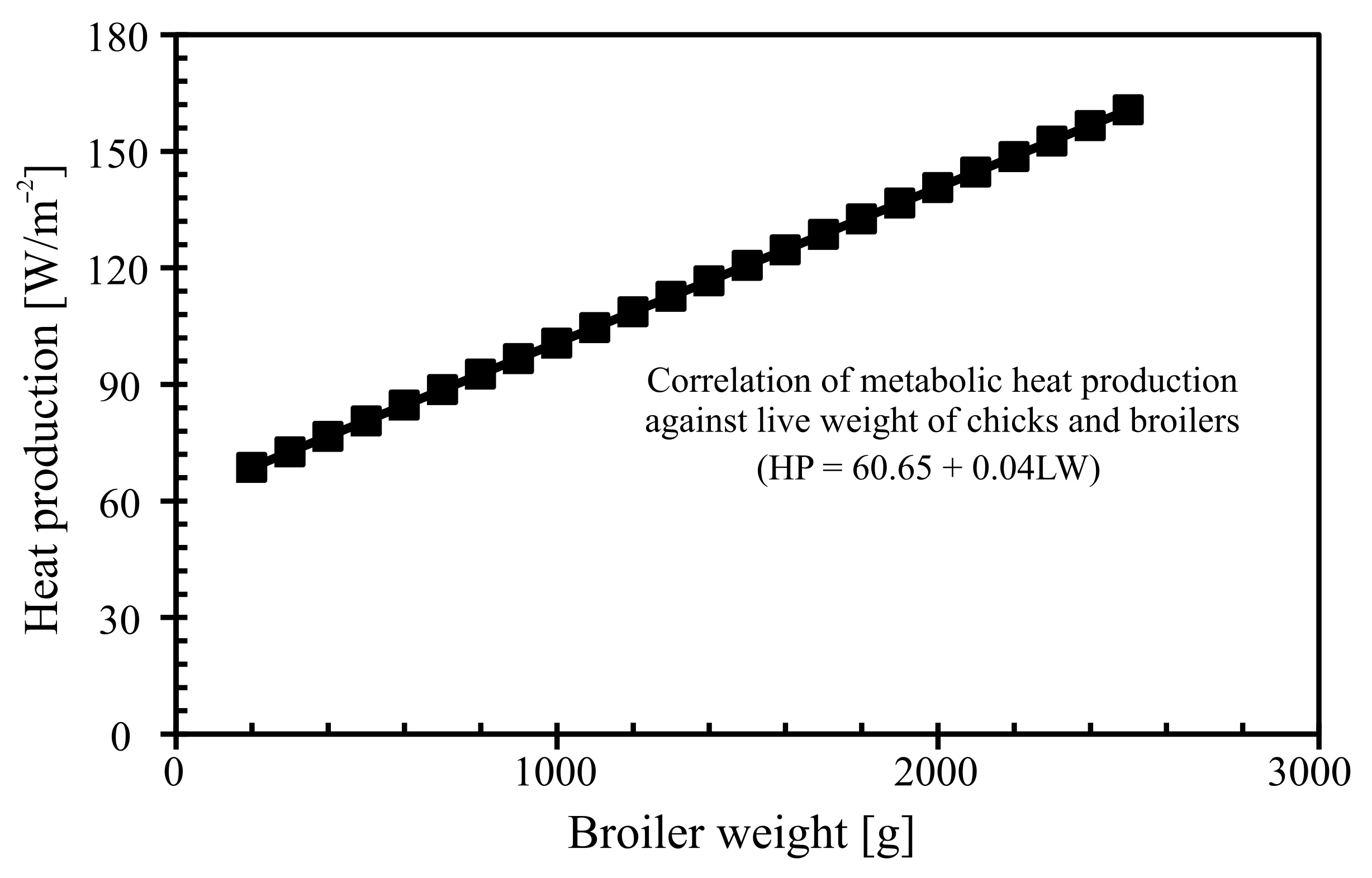

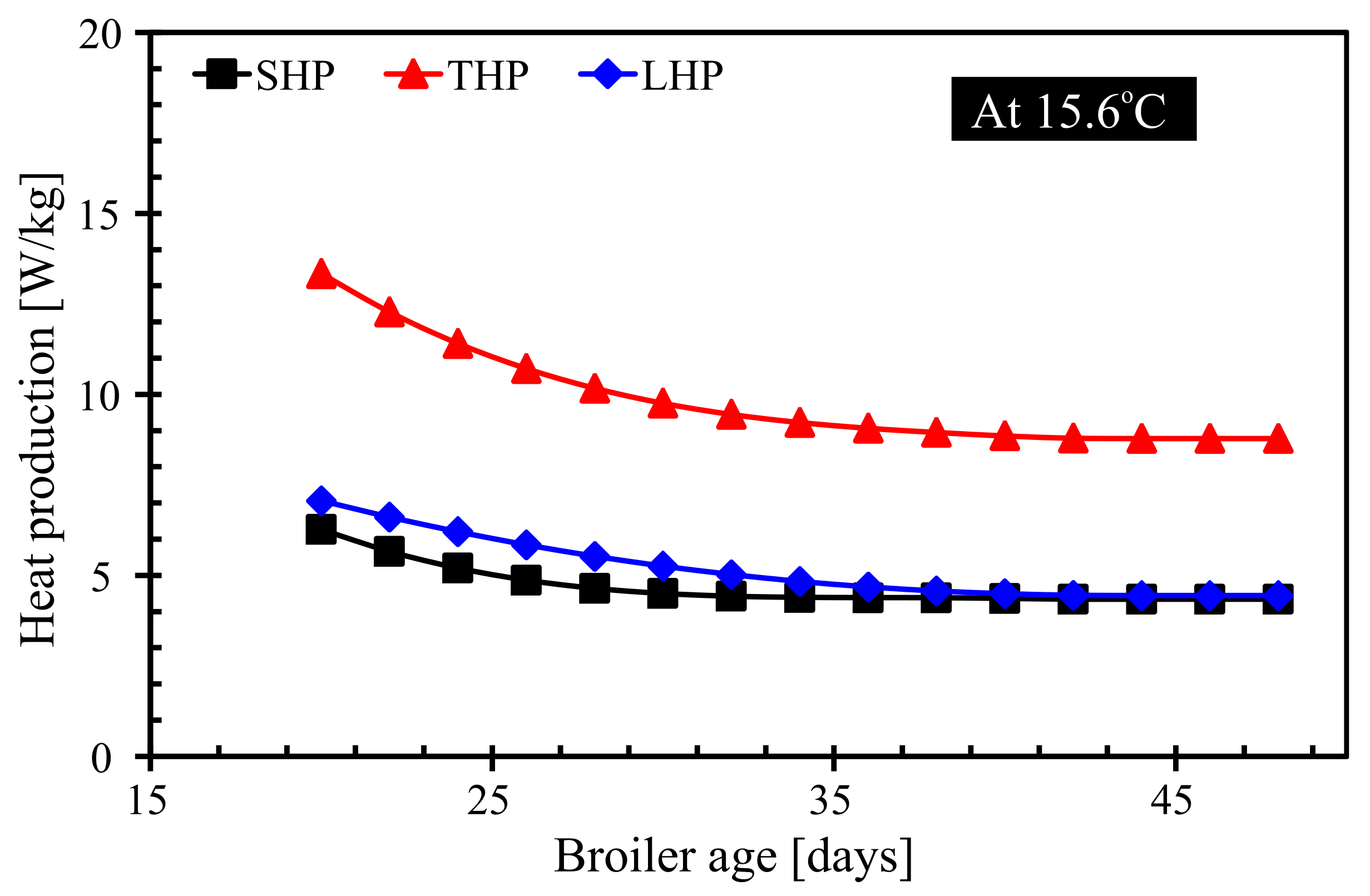
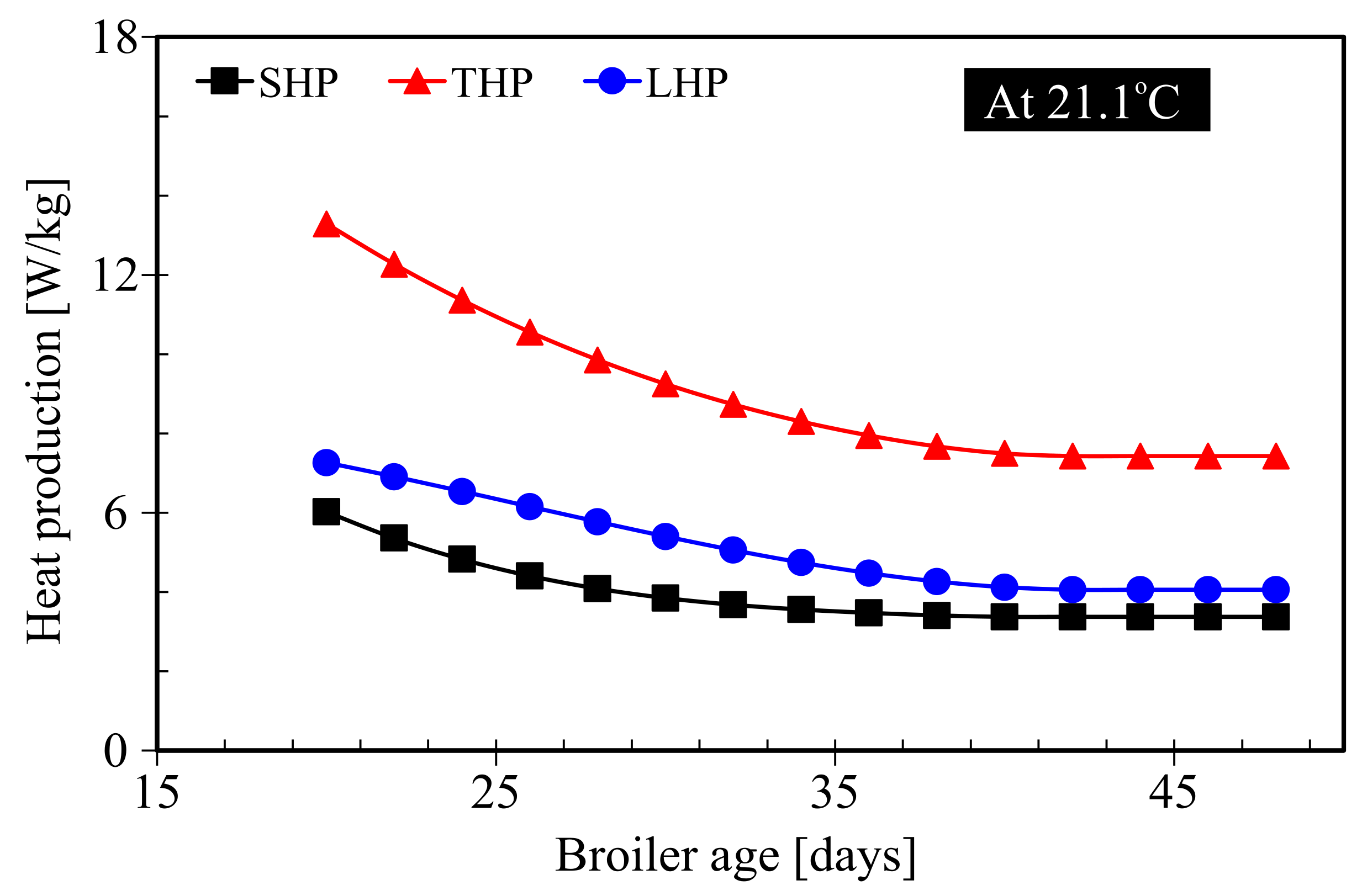


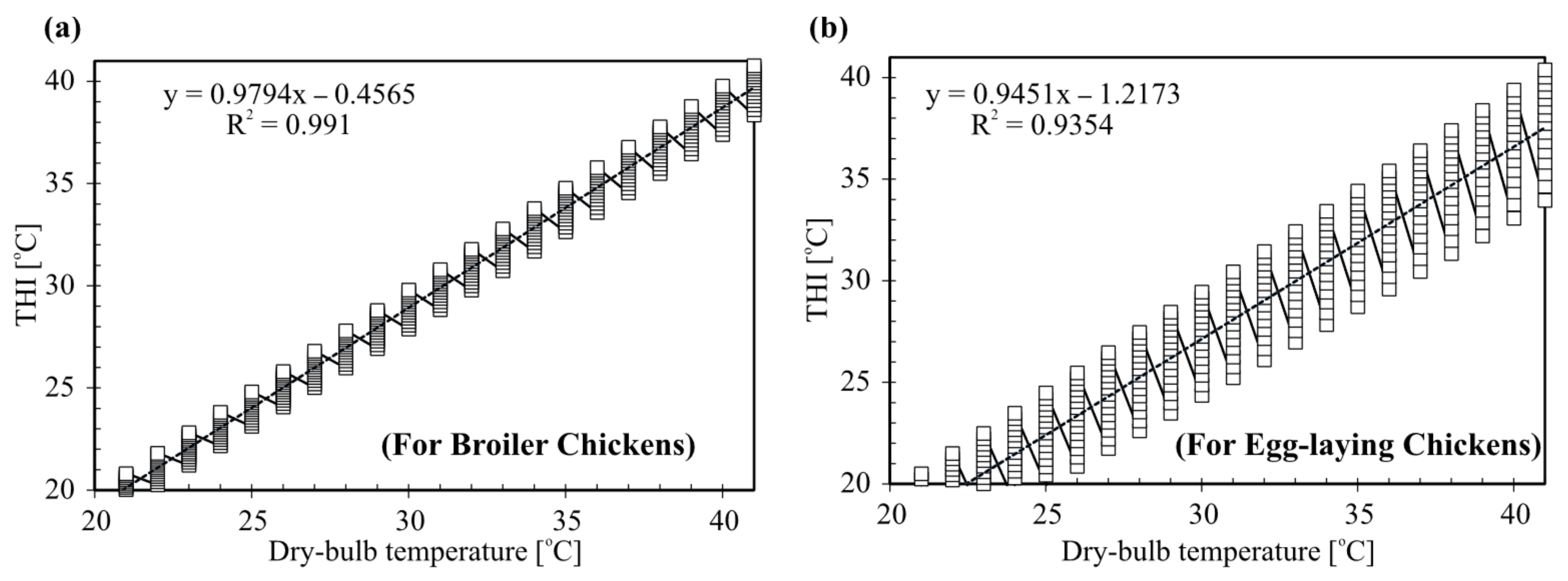
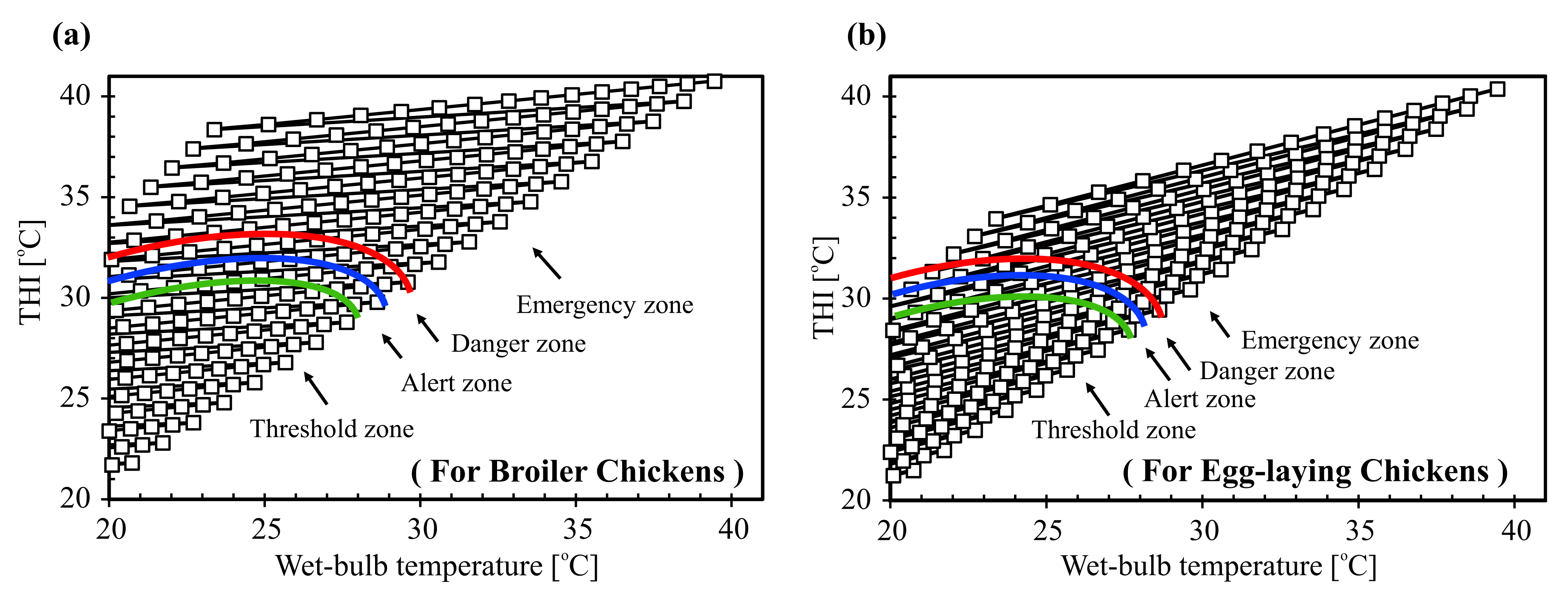
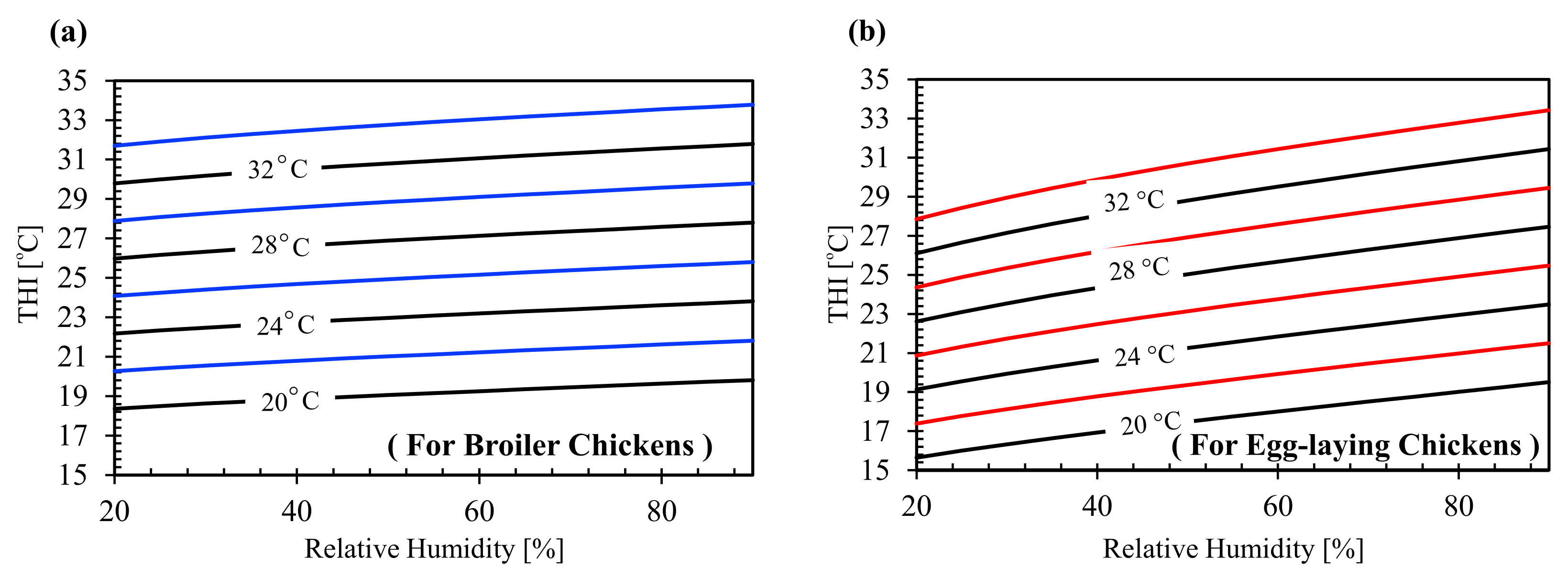

| Month | Ambient Temperature | Ambient RH | DEC | IEC | MEC | ||||||
|---|---|---|---|---|---|---|---|---|---|---|---|
| ∆T | ∆RH | ∆THI | ∆T | ∆RH | ∆THI | ∆T | ∆RH | ∆THI | |||
| (°C) | (%) | (°C) | % | (°C) | (°C) | % | (°C) | (°C) | % | (°C) | |
| Apr | 36.5 | 39.5 | 10 | 48.5 | 9 | 6.5 | 23 | 6.5 | 12 | 37.5 | 10 |
| May | 37.5 | 36 | 10 | 49 | 8.5 | 6.5 | 20.5 | 5 | 11.5 | 42 | 9.5 |
| Jun | 38 | 44 | 7 | 48 | 8.5 | 5 | 19.5 | 7 | 9.5 | 39 | 10 |
| Jul | 37.5 | 66 | 5.5 | 21 | 3.5 | 4.5 | 12.5 | 3 | 7 | 30.5 | 5.5 |
| Aug | 38.5 | 62 | 7 | 26 | 4.5 | 4.5 | 15.5 | 3 | 7.5 | 31.5 | 5.5 |
| Sep | 35 | 55 | 6.5 | 36 | 5 | 3.5 | 16.5 | 3.5 | 7 | 34.5 | 6 |
Publisher’s Note: MDPI stays neutral with regard to jurisdictional claims in published maps and institutional affiliations. |
© 2021 by the authors. Licensee MDPI, Basel, Switzerland. This article is an open access article distributed under the terms and conditions of the Creative Commons Attribution (CC BY) license (http://creativecommons.org/licenses/by/4.0/).
Share and Cite
Shahzad, K.; Sultan, M.; Bilal, M.; Ashraf, H.; Farooq, M.; Miyazaki, T.; Sajjad, U.; Ali, I.; Hussain, M.I. Experiments on Energy-Efficient Evaporative Cooling Systems for Poultry Farm Application in Multan (Pakistan). Sustainability 2021, 13, 2836. https://doi.org/10.3390/su13052836
Shahzad K, Sultan M, Bilal M, Ashraf H, Farooq M, Miyazaki T, Sajjad U, Ali I, Hussain MI. Experiments on Energy-Efficient Evaporative Cooling Systems for Poultry Farm Application in Multan (Pakistan). Sustainability. 2021; 13(5):2836. https://doi.org/10.3390/su13052836
Chicago/Turabian StyleShahzad, Khawar, Muhammad Sultan, Muhammad Bilal, Hadeed Ashraf, Muhammad Farooq, Takahiko Miyazaki, Uzair Sajjad, Imran Ali, and Muhammad I. Hussain. 2021. "Experiments on Energy-Efficient Evaporative Cooling Systems for Poultry Farm Application in Multan (Pakistan)" Sustainability 13, no. 5: 2836. https://doi.org/10.3390/su13052836
APA StyleShahzad, K., Sultan, M., Bilal, M., Ashraf, H., Farooq, M., Miyazaki, T., Sajjad, U., Ali, I., & Hussain, M. I. (2021). Experiments on Energy-Efficient Evaporative Cooling Systems for Poultry Farm Application in Multan (Pakistan). Sustainability, 13(5), 2836. https://doi.org/10.3390/su13052836














